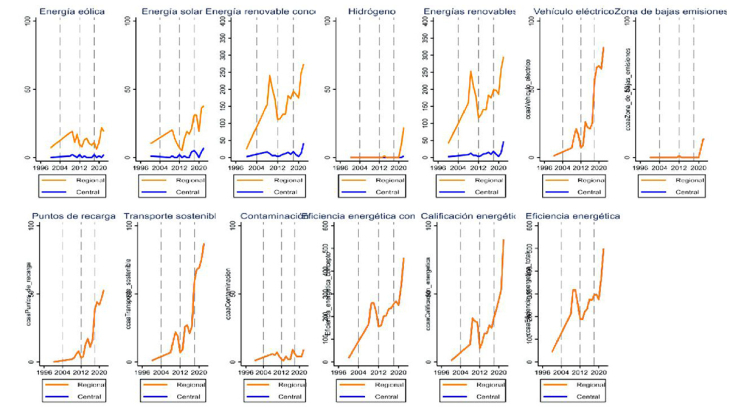In the context of growing concern about climate change and environmental sustainability, public policy plays a key role. One of the most common tools used by governments to promote sustainability is regulation. But what is the effect of this “green regulation” on firms? Does it encourage innovation, or does it hinder firms’ ability to grow and adapt?
This paper examines that question by analysing how environmental regulation has affected business innovation in Spain between 2008 and 2022. We developed a novel dataset that quantifies every national and regional regulation related to renewable energies, energy efficiency, sustainable transportation, and pollution control. This approach allows us to trace the evolution of green regulation over time and across Spanish regions.
One of the key findings is that green regulation in Spain has increased significantly since the early 2000s, especially in recent years. However, there is substantial variation across regions and policy domains. This reflects both Spain’s decentralized governance and the growing political and social focus on environmental issues. For example, regulations concerning renewable energy and energy efficiency have seen the most significant growth. These trends are effectively visualized in the Figure below, which shows the number of green regulations over time by topic and by level of administration (central vs. regional).
Our study builds on two main hypotheses:
1. More regulation can foster innovation: According to the Porter’s (1995) Hypothesis, well-designed environmental regulations can drive firms to innovate to meet higher standards, turning regulatory pressure into a competitive advantage.
2. Multi-level governance matters: When both national and regional regulations are implemented in a coherent and complementary way, they can enhance innovation by providing clear incentives and reducing uncertainty. However, if the regulations are fragmented or contradictory, they can increase compliance costs and discourage innovation.
To test these hypotheses, we combine our regulatory dataset with firm-level innovation data and other economic indicators. The analysis shows that a higher volume of green regulations is associated with higher levels of business innovation, particularly in sectors under strong environmental pressure. Furthermore, when national and regional regulations are well-coordinated, they reinforce this positive effect. However, the study also warns that if national and regional regulations are not well coordinated—resulting in overlapping, inconsistent, or fragmented frameworks—this can increase uncertainty and compliance costs for firms, ultimately discouraging innovation and reducing the effectiveness of green policies.
This article represents a pioneering effort in its field: it is the first study to examine the relationship between green regulation and innovation at the regional level in Spain. Its findings are relevant not only for the Spanish case but also for other countries with decentralized environmental governance structures. The study offers valuable insights for policymakers aiming to balance environmental protection and economic competitiveness.
Keywords: Green Regulation, Innovation, Porter Hypothesis, Renewable Energy, Business.
Codes JEL : K32, Q5, O44, O13.
